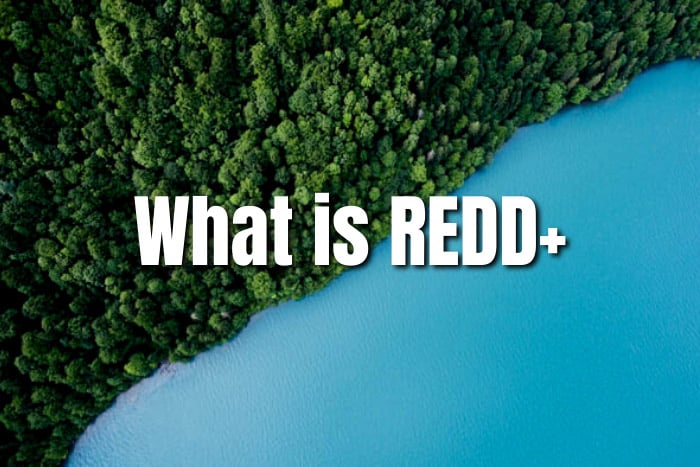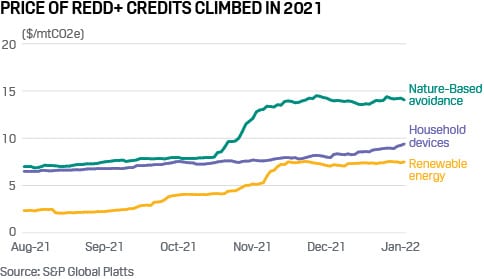In the world of carbon emissions reduction, there’s one concept that receives a lot of attention when it comes to crediting forest protection – REDD+ – but what exactly does it mean? How does it differ from REDD?
Many are also asking about what are REDD+ strategies and how they’re being funded. Others are also wondering if they are indeed a better alternative logging or if they’re really sustainable.
If you also have the same questions and more in mind, then this article will give you the answers. We’ll discuss all about REDD+, what it means, who started it, how it’s funded, the different approaches to it, and more.
What is the Difference Between REDD and REDD+?
Greenhouse gas emissions due to deforestation and forest degradation account for nearly 20% of global GHG emissions. It is for this reason that REDD is seen as a crucial part of any climate change mitigation actions.
REDD stands for “reducing emissions from deforestation and forest degradation”. It refers to all activities that do just that.
So what about REDD+, what does it mean, and how does it differ from REDD?
Though they’re very much similar, they’re different from each other. But the only difference is the “plus” which refers to the “role of conservation, sustainable management of forests and enhancement of forest carbon stocks in developing countries”.
Who Started REDD+?
The framework is created by the UNFCCC Conference of the Parties (COP) to help guide activities in the forest sector. It was first introduced in 2007 and the Paris Agreement brought it into fruition.
- The Agreement links individual forestry projects and REDD+ strategies of their host countries.
Article 5 of the Agreement is dedicated to the contribution of forests to mitigating climate change. Under this article, it becomes the duty of all rainforest nations to give REDD+ due importance by supporting its implementation in line with all UNFCCC decisions.
The same article also formalizes the architecture of the REDD+ mechanism and all the details and guidance in adopting it. The implementation of its activities is voluntary and depends on the circumstances and capabilities of each developing country.
Unfortunately, it hasn’t achieved its full potential yet as a large-scale funding mechanism to pay rainforest countries and communities for avoided forest emissions.
To limit global warming increase to 2°C or 1.5°C at the best, emissions from forest loss must be stopped.
Not only does forest loss worsen the climate crisis, it also poses threats to biodiversity. It also impacts the lives of billions of people living on forest resources.
And so protecting forests is an urgent action. But it also calls for large sums of money to do that successfully. In fact, it needs hundreds of billions of dollars of investments to carry out REDD+ strategies.
What are REDD+ Strategies?
REDD+ strategies refer to a set of policies and programs meant to reduce emissions from deforestation and forest degradation. All the while enhancing carbon uptake from other forest protection activities.
The strategies define the following elements of REDD+:
- Direct and indirect drivers of deforestation
- Baselines and forest monitoring systems
- Reference emissions levels
- Social and environmental safeguards
Those strategies have become a catalyst to help countries analyze and reform wider forestry, land tenure and sustainable development policies.
They have also helped boost the engagement of a wider range of stakeholder groups in forest and land management. They include the indigenous peoples, women and other forest-dependent communities. All these gave those groups more access and rights to forestry and land use decision making.
But there’s another important question that stakeholders demand an answer – is REDD+ sustainable? Why is it a better alternative to logging?
Sustainability of Forest Protection Programs
Simply put, REDD+ involves some kind of incentive for altering the way forest resources are used and managed. As such, it offers a new way of cutting carbon emissions by incentivizing actions that avoid forest loss or degradation.
These transfer mechanisms often include payments via carbon credits. And these credits are paid not just for keeping the trees standing; they’re given for lowering the historical amount of emissions emitted.
Forestland owners will be penalized if they cut down trees and so loss the potential income.
On the contrary, some studies showed that outcomes from REDD+ programs are even more competitive than what logging provides.
That’s for the reason that the “plus” offers several co-benefits that don’t tackle carbon emissions only but also gives local communities more benefits. These include improved access to forest resources and better quality of living.
REDD+ projects contribute directly to achieving the UN Sustainable Development Goals (SDGs). They addresses SDGs on poverty reduction, health and well-being, hunger alleviation, and improving institutions.
On the other hand, logging provides financial income only and most of the benefits or profits go to company owners, not the local community.
Better yet, technological advancements are changing the game when it comes to monitoring what’s going on in forests, both below and above ground. Overseers can now produce exact forest carbon stock data, keep track and respond to risks, and show the rate of regenerating the forest.
Best of all, there have been instruments in place that resolve concerns surrounding forestry projects. They act as an insurance mechanism against uncertainties in calculating carbon credits from forestry projects.
And as countries create various kinds of REDD+ strategies to fit their needs, there’s a common principle underlying all of them. That is:
They must result in real, measurable and long-term benefits related to the mitigation of climate change and align with national development strategies of those countries.
What are REDD+ Countries?
REDD+ countries are developing nations located in a subtropical or tropical area that have signed a Participation Agreement to participate in the Readiness Fund. Together they form the Forest Carbon Partnership Facility or FCPF.
There are 47 developing countries that were initially selected to join the FCPF – 18 are in Africa, 18 in Latin America, and 11 in the Asia-Pacific region.
The FCPF created a framework and processes for REDD+ readiness. It helps countries get ready for future systems of financial incentives for REDD+.
By using the framework, countries develop an understanding of what it means to be ready for REDD+. They’re now focusing on operationalizing both their REDD+ strategies and proposals for larger forestry programs.
At the readiness stage, that means formulating national strategies that prioritize key drivers of deforestation and degradation. It also involves proposing realistic means to fix barriers to become a REDD+ country.
- Their ultimate goal is to build investment packages that will produce emissions reductions and results-based finance.
Carbon markets have been recognized as a good source of finance where REDD+ carbon credits come in.
As of 1st quarter of 2022, more than 398 million REDD+ credits have been issued on the voluntary carbon market (VCM). That amount represents a quarter of total voluntary carbon credits issued.
When it comes to its performance, here’s how REDD+ carbon credits price has grown. It’s part of the nature-based avoidance credits.
Given the high potential of REDD+ in avoiding emissions and delivering other impacts, governments and companies become interested in investing in REDD+ strategies. But how can they help fund these projects?
How REDD+ is Funded?
There’s a national REDD+ funding mechanism that serves as a fund coordination and distribution platform for those who are willing to financially support the implementation of REDD+ strategies. Via this funding mechanism, donors or contributors can commit resources to the fund.
Financial support for the projects can also be done up front to back different activities. They range from delivering technical assistance to building capacity and executing REDD+ strategies on the ground.
- While there are many channels for the funds to support forestry projects, carbon credits have been among the top means.
To date, REDD+ credits on the VCMs are from individual projects. This is when REDD+ activities are focused on a specific area of forest where a baseline of deforestation is established. The reference data covers only the nearby forested areas, not the national level.
The number of credits issued depends on how much deforestation has reduced relative to the baseline. So far, individual projects are the successful approach in getting REDD+ carbon credits to the VCM.
In addition, despite criticisms surrounding the project’s MRV – monitoring, reporting, and verification – technological advancements resolve them. These include the high resolution, multi-model satellite imagery, Lidar, and real-time data transmission.
Analysis shows that REDD+ projects yield many credits with verifiable, additional, and long-term carbon emission reductions, as well as measurable co-benefits.
However, there are a couple of challenges to individual project-level REDD+. These include:
- inflated baselines,
- underreporting of deforestation,
- forest loss causing permanence risk, and
- risks caused by land tenure and rights
It is for these issues that going for a jurisdictional approach can help fix the problem.
This approach follows the same concept of REDD+ but differs from project-based in scale; it covers national forests. Plus, jurisdictional REDD+ have not been used to issue voluntary carbon credits.
Rather, it helps generate the new asset in the carbon market – sovereign carbon credits. It’s also used as a basis for results-based finance agreements between nations or with multilateral organizations like the World Bank.
What makes it different from project-level is that it considers all the national or subnational forests when establishing a baseline and monitoring progress. And with the advances of artificial intelligence and remote-sensing, it becomes possible to achieve it with high accuracy.
Jurisdictional REDD+ reduces the risk of over-crediting due to inflated baselines. It also allows for more efficient use of the government’s resources. This can help hasten access to upfront funding.
Meanwhile, some countries are also considering other approaches in their strategies such as the nested approach.
Nested program align with jurisdictional baselines and serve as an intermediate step between the two different approaches. They may also offer a good solution to overcoming the challenges of project-based deforestation and degradation programs.
How REDD+ countries develop their nesting approaches relates to their carbon ownership rights. Though many of them don’t mind transferring the right to produce carbon credits to private firms, it’s not always the case.
Some countries allow individual projects to become a jurisdictional program without having its own carbon crediting system. But others may also let those projects to have a separate crediting system.
Delivering Emissions Reductions
Yet, regardless of the approach, the carbon credits it generates still have to be of high quality. While jurisdictional and nested types may address systemic risks, it’s still crucial to ensure that the credits deliver on their emissions reduction claims.
No matter the type of REDD+ program, its carbon credits still need to be of quality. And since the factors that determine quality are diverse and can be complex, as a buyer of the credit, you should perform due diligence on any credits you buy.



